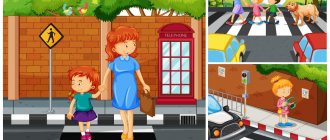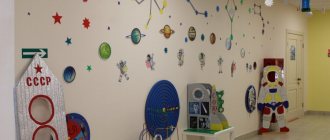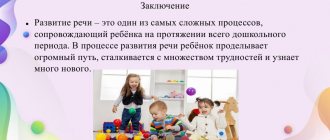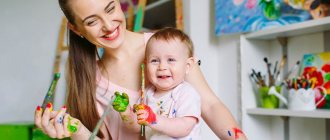Transport. Summary of GCD in 1st junior group
Abstract of GCD in the 1st junior group on the topic “Transport” Objectives: to learn to distinguish by appearance and name trucks and cars, buses, trolleybuses, as well as their main parts: cabin, steering wheel, body, wheels, windows. Materials and equipment: toy cars (car, truck, bus, trolleybus) toy steering wheel; illustrations. Musical accompaniment: “Jolly Train” (music by E. Komponeets). 1. Organizational moment. Children greet guests. And now we are going on a trip by bus. Guys, look at the tickets I bought for you. They are of different colors (red, yellow, green, blue). Progress of the lesson The teacher asks the children a riddle: Four wheels, Rubber tires, Motor and brakes... What is this? (car). 2. Main part. Looking at toys. The teacher shows the children illustrations of cars: a truck, a car, a bus, a trolleybus. What is this? (car). Yes, these are cars, but each is called differently. This car is a passenger car. This is a cargo truck, what is this? (points to a bus, the children call it a car). And this is a trolleybus. All cars have wheels, a steering wheel, and a seat for the driver and passenger. Check if all cars have a steering wheel, wheels, and seats. What should a car have so that the driver and passengers can get in and sit in it? (door). Do all cars have a door? (children's answers). A truck has a body, in which the driver transports various goods: sand for a kindergarten, vegetables and fruits for a store, furniture for homes. And who are the trolleybuses and buses carrying (passengers). Does the bus have many seats? (a lot of) . It can carry a lot of people, but not a lot in a passenger car. And few people can fit in it. Now close your eyes guys (illustration). Train! It's not a car...even though we drive it. ..this is a train. 3. Dramatization of the song “Jolly Train”. The teacher offers the children cars in the parking lot and they can go on a train journey. Children, accompanied by music and shown by the teacher, imitate the movements and whistles of a train, moving around the entire space of the group. 4. Game “What is missing” Children approach the table on which there are toy cars. The guys name the cars. At the request of the teacher, close your eyes. The teacher removes the truck under the table, the children open their eyes, the teacher asks which car is missing (the teacher encourages the children to answer in a complete sentence: “There is no truck”). Then the teacher returns the hidden toy to its place, and the game continues until all the cars are hidden in turn. 5. Summing up and reflection And now, guys, it’s time for us to return to kindergarten. There is a bear waiting for us, we will tell him where we were. What did we do? (children's answers) What are we going to take? The bus has left... Children are offered the role-playing game “Riding the Bus.” The teacher suggests building a bus from chairs and going to the zoo.
Entertainment in the first junior group on the topic “Cars”
Category: Iudova A.S. Published: 12/10: 19326
Goal : to activate and consolidate children’s knowledge on the topic.
Equipment : Cardboard traffic light, zebra crossing, cars, green and red cardboard circle, steering wheels, large car, cars, materials for applique, rattles, audio recording.
Progress : The children have the “steering wheels” in their hands, and they “drive into the hall to the music. There is a traffic light in the center of the hall. The music turns off.
Host : Guys, look who came to visit us?
Children : Traffic light.
Presenter : That's right, traffic light.
For a long time, roads have had a master – the traffic light. The red light came on: stop, there is no way forward. The yellow eye repeats without words: be ready for the transition! When the light is green: go ahead. The path is clear! Transition!
The traffic light wants to play its game with you. And it's called "Traffic Light". If the green light comes on (the presenter shows a green circle), you and I are “going”, and if the light is red (the presenter shows a red circle), then we stand.
Game "Traffic Light".
Presenter : You guys are great! Know the colors of the traffic lights and do not break the rules! Guys, tell me, if we have the “steering wheel” in our hands and we are driving a car, then who are we?
Children : Drivers (Chauffeurs).
Presenter : Let's play the game “We are drivers.”
Game “We are drivers”.
We're going, we're going by car (driving). Press the pedal (move your foot). We turn the gas on and off (“turn the lever towards you, away from you”). We look intently into the distance (palm to forehead). The wipers clean off the drops (make circular movements with their hands) Right - left - clean! The wind ruffles your hair (ruffle your hair with your fingers). We are drivers anywhere (show right thumb)!
Presenter : That's what good drivers we are! Now, listen to the riddle from our traffic light:
“Four Wheels, Rubber Tire, Motor and Brakes... What is it?”
Children : Car!
Presenter : Correct! Car. Look what a big, beautiful car I have. Let's see what my car has?
Children : Rudder. Wheels. Windows.
Presenter (shows a car on a landscape sheet without wheels or windows): Look, our cars can’t drive because they’re broken. What do cars not have? (Children's answers). Shall we fix our cars? (Children's answers).
Application "Cars".
The music started playing.
Presenter : Oh! What is this? It seems that our friend “Traffic Light” is calling us to dance. Children get up from their chairs and run to the mat to dance. There are a lot of cars on the rug. There is a zebra crossing to the side.
Host : Look how many cars are driving along the road, we can’t cross it. What do we do?
Children's answers.
The presenter leads the children to the fact that there is a pedestrian crossing on the road and they can cross the road along it.
Presenter : So you and I came to our friend Traffic Light.
Dance with rattles: “We go, we go, we go.”
Presenter : That's how great we are! Let's say goodbye to our Traffic Light! And we'll go back to our group.
The children say : “Bye” and wave their hand. Music sounds, the children “leave”.
Photos can be viewed in our photo album!
Teachers: Iudova A.S., Chistyakova I.A., Smirnova O.N.. MADOU “Kindergarten” in the village of Pes
Planning on the topic “Transport” (first junior group)
Tatiana Leksanova
Planning on the topic “Transport” (first junior group)
Educational activities.
Reading fiction. Reading N. Pavlova’s story “By Car.” Promote the formation of friendly relations and mutual assistance. Encourage children to answer questions about the content of the story.
Cognitive activity. Examination of the plot pictures “Special machines”. Give children an idea of what types of machines there are and their purpose.
Cognitive activity. Examination of illustrations "Transport" . Introduce children to objects in their immediate environment and vehicles. To promote the ability to distinguish vehicles in a picture, find similarities and differences, and name them.
Communication activities. “A bear arrived on a bus” - to promote children’s ability to distinguish between trucks and passenger vehicles, and to correctly name the parts of the car (cabin, steering wheel, wheels, body, doors).
Construction. "Bus (car)." To promote the ability to use techniques for placing building parts on top of each other, to improve actions during construction, to consolidate the concept of size and color.
Visual activities (modeling). "Airplane". To promote children's ability to roll plasticine between their palms with straight movements, to connect parts, creating a given image.
Visual activities (drawing). “Road for a car” - to promote the ability to draw horizontal lines with a brush.
Development of movements
“Cars are driving down the street” - encourage children to move in a given direction.
“We’re going to visit the bunny” - to train children in the ability to move one after another, holding on to a string.
“Train” - practice walking in a given direction.
“Cars” - promote the development of attention, coordination of movement, and the ability to act in a team.
"Planes" - encourage children to run around without bumping into each other.
“On a level path” - Exercise children in walking on a limited surface, develop balance, strengthen the foot
“Sparrows and the car” - Improve walking and running in different directions.
Observations and work assignments
Observing cars on the road - to promote children’s ability to distinguish and name trucks and cars, and compare them by size.
Construction of roads and houses from sand - develop children's imagination. Encourage the use of words in speech: “truck”, “garage”, “turn”.
Observation “Studying transport.” To promote the ability to distinguish and name trucks and cars. Find differences and similarities. Follow traffic rules.
Collecting toys using trucks encourages careful execution of the assignment.
Reading and entertainment
A. Barto “Truck”, “Plane”, “Boat” - encourage children to understand speech, pronounce words together with the teacher.
B. Zakhoder “Chauffeur”.
“Here is our train rushing” Words by T. Babajan.
Physical education leisure activity “Colored Cars” - give children pleasure from joint activities and outdoor games.
Didactic games
“Garages and cars” - promote the ability to match objects by color.
Mosaic. “Paths for cars” - encourage the formation of choosing an object of a given color.
“Big and small car” - exercise children in distinguishing between objects of two sizes.
“Make an image” (transport) - promote the formation of a whole picture, from two (four) parts.
Game and problem situations
The construction game “Machine” is to encourage children to create simple play structures together with an adult and play with them.
Game situation “Let's ride toys on a truck.” Introduce the use of vehicles and their functions.
Construction game "Colored Paths" - to promote the ability to select objects by color.
Game situation “Let's teach Katya the doll how to behave on the bus.” Remind children of the rules of conduct on public transport.
Construction game "Garage" - encourage children, together with the teacher, to create a small play building, measuring its size with the toy.
Game situation “Transport the cargo.” Encourage children to clean up their toys and help a friend.
The problem situation “Two boys want to play, but there is only one car” - to promote the ability to see and accept a problem situation, and solve it.
Problem situations: “The car broke down,” “The bus ran out of gas.”
Individual work
The speech game “Transport” promotes children’s ability to imitate the sounds of different types of transport and develop the articulatory apparatus.
Exercise “Where the car is humming” is to develop auditory attention.
“Color the plane (car)” - encourage children to color without going beyond the outline, and to hold the pencil correctly.
Finger game “Who has arrived” - to develop fine motor skills of the hands.
Looking at a toy truck together. Clarification of car parts (wheels, body, cabin).
Exercise “The plane is flying” - to develop a long exhalation.
Interaction with family
Reading fiction by A. Barto “Airplane”, “Truck”, “Ship”.
Observation of transport during walks (cars, buses)
Tell children about the rules of behavior on the street.
Pay attention to the pedestrian crossing, fix the colors red and green.



